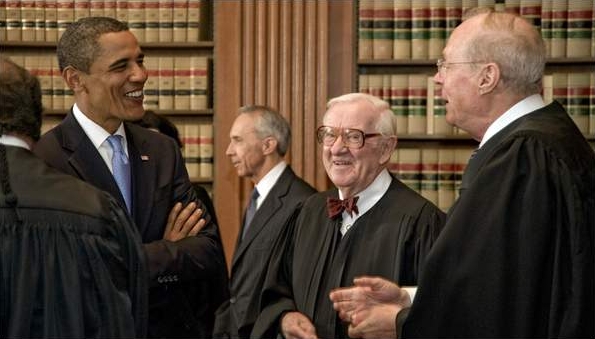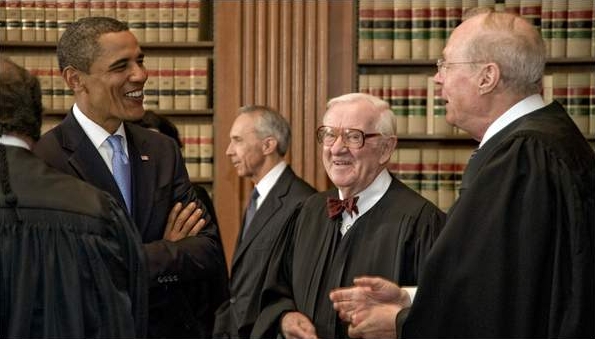 Stevens (center) with President Obama and Justice Anthony Kennedy last September.Collection of the Supreme Court of the United StatesSupreme Court Justice John Paul Stevens announced his long-expected retirement Friday, meaning we can expect another testy/goofy/”contentious” confirmation process in the Senate this summer. Stevens’ retirement means a few other things too:
Stevens (center) with President Obama and Justice Anthony Kennedy last September.Collection of the Supreme Court of the United StatesSupreme Court Justice John Paul Stevens announced his long-expected retirement Friday, meaning we can expect another testy/goofy/”contentious” confirmation process in the Senate this summer. Stevens’ retirement means a few other things too:
1. The court loses an environmental rock star.
Stevens, appointed by Gerald Ford in 1975, amassed an impressive record on environmental protection cases. He consistently upheld the ability of federal agencies to regulate pollution, as Dan Farber details on Legal Planet. In the influential Chevron v. NRDC (1984), he wrote the majority opinion defending government agencies’ ability to interpret ambiguous legislation, which enabled the EPA to set effective clean-air standards.
His crowning environmental achievement was writing the majority opinion in Massachusetts v. EPA (2007), which ruled that heat-trapping pollutants endanger public health and the EPA has an obligation to regulate them. (The Obama EPA is working on it.)
But Stevens’ influence as the court’s longest-serving member went beyond his votes. Wrote The New York Times, “beneath his amiable manner lay a canny strategist and master tactician, qualities he used to win victories that a simple liberal-conservative head count would appear to be impossible.” Whichever new guy or gal Obama chooses won’t be able to immediately replace that.
2. The new justice will be a key vote on critical environmental cases. (You don’t get scoops like that just anywhere!)
The state of Texas has already sued the EPA for seeking to limit CO2 emissions. The National Association of Manufacturers, the American Petroleum Institute, and other manufacturing groups say they will do the same. Any climate action the EPA undertakes will face a torrent of litigation. Same for any climate/energy legislation, should it ever pass out of Congress. You can expect at least some of these key cases to eventually be argued in front of the highest court in the land.
3. Bad timing for a clean-energy bill, unless it’s already screwed.
The summer confirmation process adds to an already cramped Senate calendar, which won’t make things any easier for a climate/energy bill (or financial regulation or immigration reform). And potential energy deal-broker Lindsey Graham (R-S.C.) sits on the Senate Judiciary Committee, so he’ll be spending time on confirmation hearings and dealings.
Then again, time may have already run out for a climate/energy bill in 2010. Once a bill is finally introduced (soon, they say), it will face five to six weeks of EPA review. That puts things perilously close to midterm election season, when lawmakers become even more skittish about tackling major legislation.



